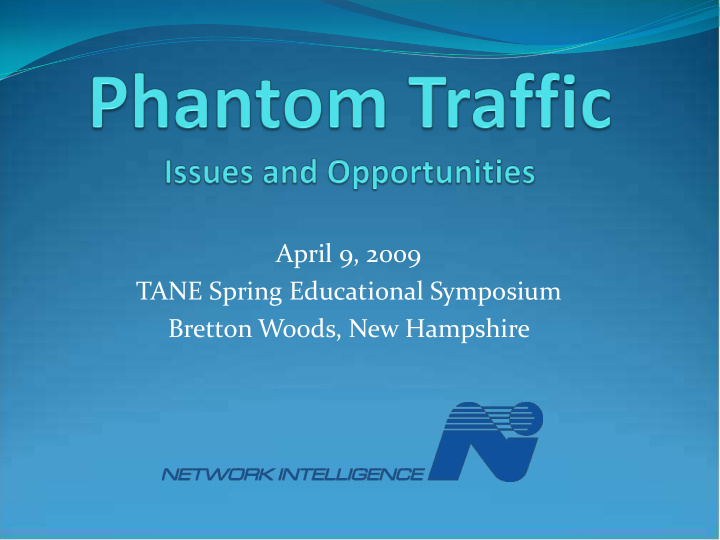



April 9, 2009 TANE Spring Educational Symposium Bretton Woods, New Hampshire
How Did We Get Here? RBOC withhold of transit traffic payments Rate-shopping Lack of visibility beyond Tandem switching layer Complexity of interconnection agreements Bypass via Protocol – SIP vs TDM “Connectionless” vs Deterministic Regulatory “Multiple Personality Disorder” Local voice is regulated (in the loop) Local voice via Voip is unregulated (using the loop) ILECs are regulated, Voip providers are not TANE Spring Educational Symposium - Network Intelligence - www.NetG2.com - info@netg2.com
Types of Phantom Traffic RBOC Tandem Transit Transit Traffic Originated via RBOC Tandem No payment by RBOC (for non-RBOC traffic) No ability to identify source of traffic No ANI Lack of real-time enforcement “Rear-View” visibility and measurement 25%-50% Revenue losses in terminating access charges TANE Spring Educational Symposium - Network Intelligence - www.NetG2.com - info@netg2.com
Types of Phantom Traffic CLEC Interconnection Favorable CLEC interconnection agreements CLECs sell terminating rate deck to IECs and Wireless providers Rate Arbitrage by CLEC Local calls sold as Terminating Access Potential for ANI manipulation CLEC retains margins ILEC improperly compensated TANE Spring Educational Symposium - Network Intelligence - www.NetG2.com - info@netg2.com
Types of Phantom Traffic IP Origination and Termination Your Customers use your unregulated DSL services to affect technical “bypass” of your regulated services Voip providers enjoy regulatory protection from payment of terminating access via IP Skype Vonage Other Voip providers purchase CLEC termination to conceal terminating access as local calls TANE Spring Educational Symposium - Network Intelligence - www.NetG2.com - info@netg2.com
Issues Barriers to Progress Lack of Network Element Control Lack of Visibility to real-time traffic Expensive accounting of past losses doesn’t translate into future revenues RBOCs are not your friends Regulatory “Firewall” Regulated vs. Unregulated services You’re not playing by the same rules Asymmetric economic model Complexity and Quantity of Interconnection Agreements Creates legal and financial barriers to resolution Multiple tariffed and contract rates for traffic delivery Encourages rate-shopping Rewards negative customer behavior TANE Spring Educational Symposium - Network Intelligence - www.NetG2.com - info@netg2.com
Opportunities and Desired Outcomes Stop the Bleeding Increase Revenues from terminating access Offer wholesaleVoip services with IP-Access services If you’re going to enable your competition, make it profitable Simplify peering and traffic-sharing agreements Streamline interconnect agreements Aggregate Assocation member traffic Ingress – United policies and tariffs Egress – Multiple Carrier LCR Peering of Association member traffic One agreement, not 22 agreements TANE Spring Educational Symposium - Network Intelligence - www.NetG2.com - info@netg2.com
Recommendations Control Tandem Access to your Network Be your own gatekeeper TDM and IP Make it difficult and expensive to “game” access services Develop portfolio of Wholesale SIP services Local DID numbers Out-of-area SIP-based services Communication Integration – local, national, global SIP-enable your local network with outsourced IP Tandem Access Use a media gateway as the “Voice Demarcation” point in your netowrk Offer incentives to terminate traffic in your territory via IP Reward revenue-producing behavior Play out of both rulebooks Out of territory SIP services create revenue on unregulated side In-territory services protect current service revenues TANE Spring Educational Symposium - Network Intelligence - www.NetG2.com - info@netg2.com
Conclusions Treat the Problem, not the Symptom Phantom traffic is a symptom of a failing system Take control of your network at ALL layers Create new revenue opportunities Prevent uncompensated access to your network Aggregate traffic to reduce direct cost of termination of out-of-footprint traffic Simplify and facilitate member traffic peering TANE Spring Educational Symposium - Network Intelligence - www.NetG2.com - info@netg2.com
Hosted and Managed IPTandem Leverage Capital dollars – Opex as opposed to Capex Pay for only what you need Partition larger platform Outsource management of hosted platform Keep services in deregulated side Re-deploy HR assets Reduce time managing multiple peering agreements Reduce legal and regulatory expense Be a net seller, not a net purchasor of services Develop deregulated services at Tandem layer that leverage regulated infrastructure – just like your competitors Outsource association traffic aggregation, peering, and settlements TANE Spring Educational Symposium - Network Intelligence - www.NetG2.com - info@netg2.com
Recommend
More recommend